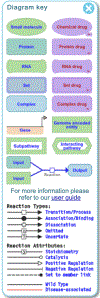Using the Reactome Database
- PMID: 37053306
- PMCID: PMC11184634
- DOI: 10.1002/cpz1.722
Using the Reactome Database
Abstract
Pathway databases provide descriptions of the roles of proteins, nucleic acids, lipids, carbohydrates, and other molecular entities within their biological cellular contexts. Pathway-centric views of these roles may allow for the discovery of unexpected functional relationships in data such as gene expression profiles and somatic mutation catalogues from tumor cells. For this reason, there is a high demand for high-quality pathway databases and their associated tools. The Reactome project (a collaboration between the Ontario Institute for Cancer Research, New York University Langone Health, the European Bioinformatics Institute, and Oregon Health & Science University) is one such pathway database. Reactome collects detailed information on biological pathways and processes in humans from the primary literature. Reactome content is manually curated, expert-authored, and peer-reviewed and spans the gamut from simple intermediate metabolism to signaling pathways and complex cellular events. This information is supplemented with likely orthologous molecular reactions in mouse, rat, zebrafish, worm, and other model organisms. © 2023 The Authors. Current Protocols published by Wiley Periodicals LLC. Basic Protocol 1: Browsing a Reactome pathway Basic Protocol 2: Exploring Reactome annotations of disease and drugs Basic Protocol 3: Finding the pathways involving a gene or protein Alternate Protocol 1: Finding the pathways involving a gene or protein using UniProtKB (SwissProt), Ensembl, or Entrez gene identifier Alternate Protocol 2: Using advanced search Basic Protocol 4: Using the Reactome pathway analysis tool to identify statistically overrepresented pathways Basic Protocol 5: Using the Reactome pathway analysis tool to overlay expression data onto Reactome pathway diagrams Basic Protocol 6: Comparing inferred model organism and human pathways using the Species Comparison tool Basic Protocol 7: Comparing tissue-specific expression using the Tissue Distribution tool.
Keywords: Reactome database; biological pathway; interaction network; pathway analysis; pathway visualization.
© 2023 The Authors. Current Protocols published by Wiley Periodicals LLC.
Conflict of interest statement
CONFLICT OF INTEREST STATEMENT:
None declared.
Figures


































References
-
- Benjamini Y, & Hochberg Y. (1995). Controlling the False Discovery Rate: A Practical and Powerful Approach to Multiple Testing. Journal of the Royal Statistical Society. Series B (Methodological), 57(1), 289–300.
MeSH terms
Substances
Grants and funding
LinkOut - more resources
Full Text Sources

